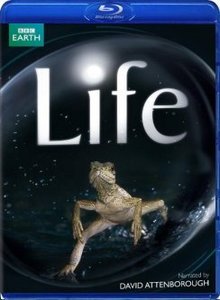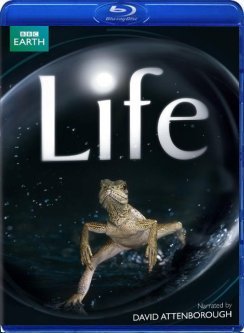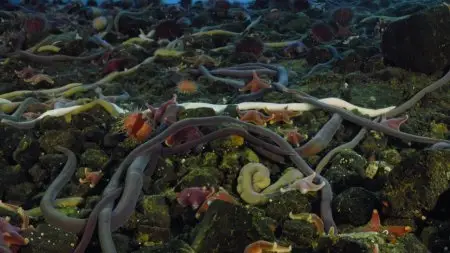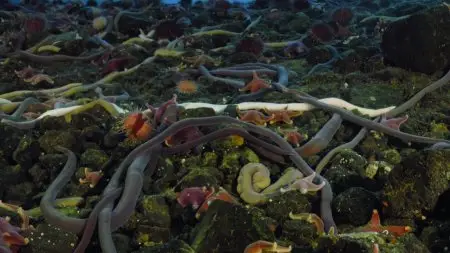BBC - Life (8 of 10) Creatures of the Deep(2009)
ENG-RUS | ENG-RUS SUBS | BDRIP | MPEG4-AVC | 1280x720 | 0h 59mn | AC3 6 ch 448kb | 2.62GB
Four years in the making, Life will set a new benchmark in family entertainment and natural history epics. Life is the latest wildlife epic from the BBC's award-winning Natural History Unit. It has the revelation, cinematic style, sense of place and emotionally involving individual sequences that that were the hallmark of The Blue Planet and Planet Earth, with all the scope, detail and content of an Attenborough epic, and the addition of close-up, intensely dramatic new behaviour all captured by the world's top wildlife photographers with the aid of the most cutting-edge and sophisticated filming techniques.
8. "Creatures of the Deep" Marine invertebrates, the descendants of one billion years of evolutionary history, are the most abundant creatures in the ocean. In the Sea of Cortez, packs of Humboldt squid make night-time raids from the deep to co-operatively hunt sardines. Beneath the permanent Antarctic sea ice of McMurdo Sound, sea urchins, red sea stars and nemertean worms are filmed scavenging on a seal carcass. A fried egg jellyfish hunts amongst a swarm of Aurelia in the open ocean, spearing its prey with harpoon-like tentacles. In the shallows off South Australia, hundreds of thousands of spider crabs gather annually to moult. Many invertebrates have simple nervous systems, but giant cuttlefish have large brains and complex mating habits. Large males use flashing stroboscopic colours and strength to win a mate, whereas smaller rivals rely on deceit: both tactics are successful. A Pacific giant octopus sacrifices her life to tend her single clutch of eggs for six months. As a Pycnopodia starfish feeds on her remains, it comes under attack from a king crab. Coral reefs, which rival rainforests in their diversity, are the largest living structures on Earth and are created by coral polyps. Porcelain crabs, boxer crabs and orangutan crabs are shown to illustrate the many specialised ways of catching food on a reef. Marine invertebrates have a lasting legacy on land too – their shells formed the chalk and limestone deposits of Eurasia and the Americas. Life on Location documents the recording of Antarctic sea life and the birth of a reef.
Available: 1. Challenges of Life, 2. Reptiles and amphibians, 3. Mammals, 4. Fish, 5. Birds, 6. Insects, 7. Hunters and Hunted.
http://rapidshare.com/files/364100640/L8.part01.rar
http://rapidshare.com/files/364107202/L8.part02.rar
http://rapidshare.com/files/364113830/L8.part03.rar
http://rapidshare.com/files/364127887/L8.part04.rar
http://rapidshare.com/files/364141349/L8.part05.rar
http://rapidshare.com/files/364151775/L8.part06.rar
http://rapidshare.com/files/364163307/L8.part07.rar
http://rapidshare.com/files/364174801/L8.part08.rar
http://rapidshare.com/files/364185182/L8.part09.rar
http://rapidshare.com/files/364195465/L8.part10.rar
http://rapidshare.com/files/364205999/L8.part11.rar
http://rapidshare.com/files/364214832/L8.part12.rar
http://rapidshare.com/files/364221060/L8.part13.rar
http://rapidshare.com/files/364227190/L8.part14.rar
http://rapidshare.com/files/364233788/L8.part15.rar
http://rapidshare.com/files/364240551/L8.part16.rar
http://rapidshare.com/files/364264655/L8.part17.rar
http://rapidshare.com/files/364291870/L8.part18.rar
http://rapidshare.com/files/364317539/L8.part19.rar
http://rapidshare.com/files/364338985/L8.part20.rar
http://rapidshare.com/files/364344147/L8.part21.rar
http://rapidshare.com/files/364348377/L8.part22.rar
http://rapidshare.com/files/364353182/L8.part23.rar
http://rapidshare.com/files/364357933/L8.part24.rar
http://rapidshare.com/files/364362949/L8.part25.rar
http://rapidshare.com/files/364367525/L8.part26.rar
http://rapidshare.com/files/364372543/L8.part27.rar
http://rapidshare.com/files/364377871/L8.part28.rar
http://rapidshare.com/files/364379585/L8.part29.rar
http://rapidshare.com/files/364107202/L8.part02.rar
http://rapidshare.com/files/364113830/L8.part03.rar
http://rapidshare.com/files/364127887/L8.part04.rar
http://rapidshare.com/files/364141349/L8.part05.rar
http://rapidshare.com/files/364151775/L8.part06.rar
http://rapidshare.com/files/364163307/L8.part07.rar
http://rapidshare.com/files/364174801/L8.part08.rar
http://rapidshare.com/files/364185182/L8.part09.rar
http://rapidshare.com/files/364195465/L8.part10.rar
http://rapidshare.com/files/364205999/L8.part11.rar
http://rapidshare.com/files/364214832/L8.part12.rar
http://rapidshare.com/files/364221060/L8.part13.rar
http://rapidshare.com/files/364227190/L8.part14.rar
http://rapidshare.com/files/364233788/L8.part15.rar
http://rapidshare.com/files/364240551/L8.part16.rar
http://rapidshare.com/files/364264655/L8.part17.rar
http://rapidshare.com/files/364291870/L8.part18.rar
http://rapidshare.com/files/364317539/L8.part19.rar
http://rapidshare.com/files/364338985/L8.part20.rar
http://rapidshare.com/files/364344147/L8.part21.rar
http://rapidshare.com/files/364348377/L8.part22.rar
http://rapidshare.com/files/364353182/L8.part23.rar
http://rapidshare.com/files/364357933/L8.part24.rar
http://rapidshare.com/files/364362949/L8.part25.rar
http://rapidshare.com/files/364367525/L8.part26.rar
http://rapidshare.com/files/364372543/L8.part27.rar
http://rapidshare.com/files/364377871/L8.part28.rar
http://rapidshare.com/files/364379585/L8.part29.rar
http://letitbit.net/download/4922.4a76133218eaa431cda2a2f2d1/L8.part1.rar.html
http://letitbit.net/download/6110.68db02b0edbdc49aeed2b24249/L8.part2.rar.html
http://letitbit.net/download/0141.07766d372257a41ec7205cb840/L8.part3.rar.html
http://letitbit.net/download/6267.6352862753532a869ec735b7e0/L8.part4.rar.html
http://letitbit.net/download/8184.8b9b258e32410e0a0ffdaab490/L8.part5.rar.html
http://letitbit.net/download/5637.5ca62815ec1c18ea4521dd65f1/L8.part6.rar.html
http://letitbit.net/download/6110.68db02b0edbdc49aeed2b24249/L8.part2.rar.html
http://letitbit.net/download/0141.07766d372257a41ec7205cb840/L8.part3.rar.html
http://letitbit.net/download/6267.6352862753532a869ec735b7e0/L8.part4.rar.html
http://letitbit.net/download/8184.8b9b258e32410e0a0ffdaab490/L8.part5.rar.html
http://letitbit.net/download/5637.5ca62815ec1c18ea4521dd65f1/L8.part6.rar.html









